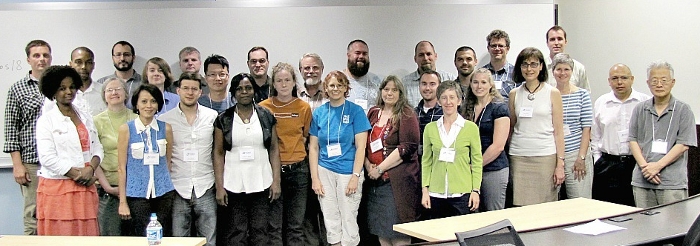| Description | Participants | Agenda (pdf) | Products | Videos |
|---|
NIMBioS Tutorial
Algebraic and Discrete Biological Models for Undergraduate Courses

Topic: Algebraic and discrete biological models for undergraduate courses
Meeting dates: June 18-20, 2014. Participants arrive on June 17 and depart on June 21.
Location: NIMBioS at the University of Tennessee, Knoxville
Organizers:
Raina Robeva, Mathematics, Randolph-Macon College
Robin Davies, Biology, Sweet Briar College
Terrell Hodge, Mathematics, Western Michigan Univ.
Matthew Macauley, Mathematical Sciences, Clemson Univ.
Description: The field of mathematical biology has been transformed over the past 15 years by researchers using novel tools from discrete mathematics and computational algebra to tackle old and new problems. This tutorial exposed participants to algebraic and discrete approaches to problems from modern biology including gene regulation, gene identification, RNA folding, phylogenetics, and metabolic pathway analysis. The tutorial format included interactive lectures with quick exercises on each topic, followed by structured hands-on activities during which participants worked in small groups on exercises and projects. During lectures and interactive sessions, participants learned web-based software systems and databases that students in their courses can use.
This tutorial was appropriate for both mathematics and biology faculty. In particular, it targeted undergraduate faculty teaching modern algebra, finite mathematics or mathematical modeling, or intermediate and advanced undergraduate biology, but many topics were also appropriate for introductory biology courses. All introductory lectures to the tutorial topics were accessible for both math and biology faculty and covered basic biology and mathematical methods, models, heuristics, computational approaches, and relevant software. Participants had the opportunity to customize their tutorial experience by opting for lectures and activities at two different levels - one introductory and one more advanced.
Tutorial objectives:
- Participants were introduced to the importance of algebraic and discrete methods and models in modern biology, as an alternative to classical continuous methods based on calculus and differential equations. They learned how to use such methods and/or build and analyze models in the context of the tutorial's topics and worked in small groups to experience how to use the methodology to describe, simulate, and analyze the relevant biological systems.
- Participants were exposed to software that implements the mathematical methods, aids visualization, and facilitates the computations and analyses.
- Participants learned of existing curricular resources related to the tutorial's topics, including exercises, projects, solution guidelines, and/or computer code and data. They received guidance on how the tutorial materials may fit into mathematics and biology courses or be used as an introduction to independent studies or undergraduate research.
Databases and software covered included (but were not limited to) DVD and ADAM (for visualization and analysis of Boolean and finite dynamical systems models), CpG Educate (for CpG island identification), BioNJ and TreeDyn and/or related analogues (for phylogenetic tree reconstruction), Metacyc, KEGG, and/or BIGG (for metabolic pathways), and Pfold (for RNA secondary structures).
Possible courses this tutorial would apply to in either math or biology or integrated curriculum: finite mathematics, discrete structures, linear algebra, modern algebra, graph theory, topology, probability, statistics, modeling, bioinformatics and biostatistics, cell and molecular biology, biochemistry, ecology, phylogenetics, and evolution.
Algebraic and Discrete Biological Models for Undergraduate Courses WordPress Site. NIMBioS has created a WordPress site to facilitate group communication and information sharing for the tutorial. This is an interactive tool for sharing resources and comments before, during and after the meeting. All participants will receive an official email from WordPress inviting you to join the site. You will be asked to click on the link in the email from WordPress to accept the invitation. Before the meeting, we encourage you to introduce yourself to the rest of the group by writing a post with some details about your background and what you hope to gain from the meeting. Full details on how to post, comment and upload files to the WordPress site are available at the site (/wordpress-training/algebraicmathbio/).
Presentations were available for viewing via live streaming during the workshop.
 Summary Report. TBA
Summary Report. TBA
Products
Publications
Albert R, Robeva R. 2015 Signaling Networks: Asynchronous Boolean models. In Robeva R (ed) Algebraic and Discrete Mathematical Methods for Modern Biology, Academic Press, pp. 65-91.
A goal of NIMBioS is to enhance the cadre of researchers capable of interdisciplinary efforts across mathematics and biology. As part of this goal, NIMBioS is committed to promoting diversity in all its activities. Diversity is considered in all its aspects, social and scientific, including gender, ethnicity, scientific field, career stage, geography and type of home institution. Questions regarding diversity issues should be directed to diversity@nimbios.org. You can read more about our Diversity Plan on our NIMBioS Policies web page. The NIMBioS building is fully handicapped accessible.
NIMBioS
1122 Volunteer Blvd., Suite 106
University of Tennessee
Knoxville,
TN 37996-3410
PH: (865) 974-9334
FAX: (865) 974-9461
Contact NIMBioS


